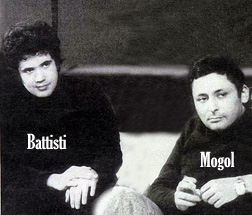



At the Sanremo Festival in 1967 The Hollies sang Non prego per me, one of his greatest songs, later recorded also by I Ribelli. In 1969 at the same musical competition he sang for the first time in front of a big audience the song Un'avventura, coupled with the soul singer Wilson Pickett. Balla Linda, one of his greatest hits, was even borrowed by the american group The Grassroots, who made it a chart-climber in the USA (as already seen with Let's live for today by The Rokes). One of his last efforts during the 60s is the song Il Paradiso, performed with success by the Italian girl singer Patty Pravo in Italy and by The Amen Corner in UK.
During the early 70s Lucio Battisti started his collaboration with La Formula 3, a rock band who backed him for quite a while, until his solo career definitely gave him the greatest succes in Italy and Europe, where he performed a lot until his retire from the live shows. The complete isolation from the mass media contributed to gain more fame and mystery about him. Lucio Battisti died of cancer in September 1998. Italy will always remember him.
45 - Per una lira / Dolce di giorno (Ricordi - 1966)
45 - Prigioniero del mondo / Balla Linda (Ricordi - 1968)
45 - Acqua azzurra acqua chiara / Dieci ragazze (Ricordi - 1969)

Soon she was called to play at the Piper (hence the Piper Girl moniker, this place was the "Temple" of the Italian beat scene!) where she received a lot of success from the young Italian beatsters and for two main reasons: one, it was the first time a girl fronted an audience playing and singing in an all-male band; two, she played in a R&B vein such songs as Sono qui con voi (Them's Baby please don't go).
Soon after she was recruited by CGD label and recorded the single Sono qui con voi / La ragazza del Piper, but only after with Nessuno mi può giudicare she became famous and won the Sanremo Festival in 1966, also this song earned her the yè yè girl moniker thanks to her particular hand-moving dance.
She starred in the same titled teen movie (Nessuno mi può giudicare) with other artists and actors as Gianni Morandi and Nino Taranto, where she played the part of a working girl at the Standa megastores who became famous by singing the new music called beat!
From this moment followed a series of hit singles: Perdono, which rose to the 3rd position on the Italian charts and titled her second teen movie (Perdono). L'Uomo d'oro, the B side of her new single, reached the 2nd position, Cento giorni, the third single, went to the 3rd (with its flip Tutto nero, one of the best rendition of the Stones' Paint it black). In 1967, Caterina recorded the last of her beat singles, Sono bugiarda (I'm a believer by the Monkees/Neil Diamond) which reached number 4 in the charts.
She also was at the Sanremo Festival coupled with Sonny & Cher singing a pathetic Il cammino di ogni speranza.
Anyway she was the purest of the 60s Italian girl singers and greatly performed lots of classics as Kicks, I believe to my soul, Mellow Yellow, The sun ain't gonna shine anymore, I've been loving you too long. In 1968 she won the Cantagiro competition with Il volto della vita (The days of Pearly Spencer by David McWilliams), but she was far from the groovy sounds of her first period, in fact this is a song with orchestral arrangements...
